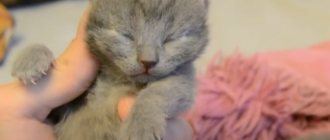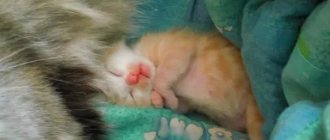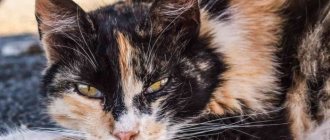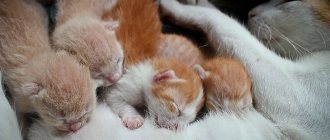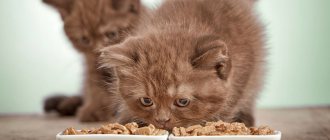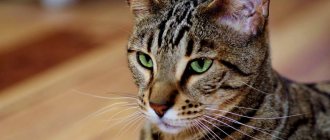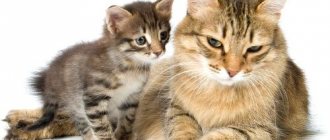14371Pavel
In order to determine how healthy a kitten is, it is very important for future owners and breeders to study the development of kittens week by week. How strong a kitten is, whether it needs additional stimulation of the immune system or care can be determined by recording changes in the development of kittens by day after birth. The correct growth of a small pet depends not only on a properly structured diet, upbringing and training, but also on compliance with the rules that are established for caring for kittens.
Development from the fourth to the sixth month
During this period, it is recommended that he trim his claws for the first time; it is necessary to monitor the following indicators:
- height, which will depend on breed and gender;
- weight, which must be at least 1.4 kg;
- constant activity and good socialization.
Until six months, it is not recommended to give the baby food that is intended for adult cats, as it will not provide the necessary development and the intake of all necessary microelements.
Results
After a year, it turns into an adult, care for which includes the following procedures:
- regular visits to the veterinarian;
- timely vaccination;
- timely nutrition, properly selected diet;
- care for hair, teeth and nails.
If you pay due attention to the upbringing of your pet, then the development of the pet, both on the physical and psychological levels, will go quite smoothly and you will receive an obedient and pliable pet that will delight you with its appearance and friendliness throughout its life.
Stages of kitten development by month
Once born, kittens grow and develop during the first year of life. “Coming of age” in cats occurs at 12 months. At each stage of growth, the baby requires appropriate care: nutrition, weight control, medical examination, vaccinations, etc.
I recommend: How to determine the age of a kitten: basic methods and calculation options
First 7 days of life
Week-old babies are growing rapidly
For your information! Colostrum is unique and irreplaceable: with it, kittens receive not only food, but also their first vaccination. It is very important that babies eat colostrum: it strengthens their immunity.
The mother cat spends all the time with her children, only leaving occasionally to eat. In the first days after birth, kittens navigate only by smell and touch: they can find their mother at a distance of 60 cm. They can squeak, and a little later they learn to purr.
Newborn kittens have reflexes responsible for their vital functions:
The kitten begins to hear 5-8 days after birth. But despite this, he still does not know how to navigate by sound. It is necessary to place the kittens in a quiet room so that they are not frightened by noise.
If a kitten refuses to suckle breast milk, he needs to be given an injection of Gamavit or Aminovit. You can put 2 drops of Travmatin in your mouth.
Week-old kittens eat only their mother's milk. At this age, they already hear, but do not see yet. They must be weighed twice a day and weight gain must be constantly monitored.
Second week of life
On the 10th or 14th day of life, kittens' eyes open. At this age, all babies have blue eyes. Their color changes closer to 3 months.
Kittens at 2 weeks weigh almost twice as much as at birth - about 200–250 g. You need to carefully monitor their diet and weight. At this age, they still feed on their mother’s milk and need her care.
Two-week-olds open their eyes and ears
You can see how adult cats trample a soft blanket with their paws and purr. This indicates that the cat is happy and content. This reflex has been preserved since childhood, when newborn kittens knead their mother’s belly to get milk.
Third week of life
Kittens develop a feeling of attachment to their mother and to each other. In the same way, they become attached to the owner. The cat begins to teach the kids.
Fourth and fifth weeks of life
At 1 month, kittens know how to wash themselves and love to play.
At 5 weeks, kittens can wash themselves and go to the litter box. Gradually they switch to solid food and drink breast milk much less often. They need to be weighed every day.
Two months of kitten life
Two-month-old kittens need to be petted and stroked frequently. During this period, their behavior changes and more activity appears. They will need toys and space to run and play.
Interesting fact! Boys grow faster than girls.
Three months of kitten life
At 2 months the first vaccinations are given
A caring owner should know what to feed a 3-month-old kitten. Special food for kittens is perfect. You can give boiled meat, cottage cheese, pates. Babies are fed 5-6 times a day, a single serving should be 100 g.
Recommend: Eclampsia in cats
Fifth month
At this age, permanent teeth grow in place of baby teeth. Favorite fluffies gain weight up to 1.8–2 kg. They need to be fed 4-5 times a day and weighed weekly. It is advisable to combine dry and wet food intended for kittens up to one year old.
Sixth month
In six-month-old animals, hormonal levels change and the process of puberty begins. They reach the size of an adult animal. It is necessary to give the kittens an anthelmintic again and take them to the veterinarian.
At this age, you can switch your pets to three meals a day. It is still necessary to feed babies baby food, because it contains many useful substances that a growing body needs.
Table No. 1. Kitten weight by week (medium sized cats)
Seventh month
Attention! Timely vaccination will save kittens' lives.
Eighth month
By this age, kittens have already grown enough and look like adults. Animals need to be sterilized at 8 months. You must first be examined by a veterinarian. An animal can be sterilized no earlier than a month after vaccination.
At 3 months, eye color changes, you need to switch to adult food
Development from 9 months to a year of life
This is the final period of childhood. Young cats at 9–12 months do not grow as quickly as before. Active, curious, playful pets still love to run and frolic.
Big cats - British and Maine Coons - weigh a little more than others.
Table No. 2. Weight of Maine Coons, Scottish and British kittens by week
What can a kitten weigh at birth?
The weight of a kitten at birth can depend on various characteristics:
- Gender. At the moment of birth, a cat may not differ in weight from a female cat, but this difference becomes noticeable after some time. Males are usually a little larger than female cats, and therefore weigh a little more.
- Number of kittens born. It has long been noted that the more numerous the litter, the greater the underweight of each individual.
- The completeness of the diet of a mother cat during pregnancy.
- Belonging to a certain breed. For example, a Maine Coon kitten at the time of birth will weigh more than a baby, for example, of the Siamese breed.
Newborn kittens of large breeds (for example, Maine Coons) will weigh more than their graceful relatives
A newborn kitten most often weighs no more than one hundred and twenty grams. He is still blind and mostly immobilized. All he can do is eat, grow and get enough sleep. Staying in this mode, the baby can gain up to 15 grams per day.
Development of a kitten in the first week
During the first 24 hours after birth, colostrum is released from the cat's nipples and it is very important that the kittens receive it. Colostrum contains a significant amount of vitamins and microelements; its consumption strengthens the immunity and health of newborn kittens.
Cat babies are born helpless and their mother helps them in everything. She constantly licks them, massaging their bellies and faces.
The main thing is to keep the area where the cat and kittens are placed clean.
Feeding in the first week
During the period when a cat is feeding kittens with milk, owners should pay special attention to the nutrition of the cat itself. Feeding should be balanced, be sure to give additional vitamins and microelements, and the cat should always have access to fresh water.
Feeding a kitten in the first week
Kitten development in the first 4 weeks
Eye color standards
Each breed has a personal accepted standard for eye color. These are quite strict rules that should not be broken.
So, which breeds have strict restrictions on eye color:
- Abyssinian cat. This breed can only have green or yellow eyes.
- Burmese cat. This beauty's eyes can only be light gold.
- Burmilla. Green of any intensity.
- Balinese. Blue or blue eyes.
- Bombay cat. Only deep copper eye color.
- Burmese cat. Exceptionally bright blue eye color.
- Havana brown. Green or yellowish-green.
- Egyptian Mau. The eyes are light green (gooseberry color).
- Korat. Amber or amber-green eyes.
- Kao-mani. Yellow or blue eyes.
- Lykoy. Yellow or amber eyes.
- Nibelung. Only gooseberry eye color.
- Oriental cat. Green eye color is preferred.
- Ojos azules. Only blue eyes.
- Pixie bob. The eyes are gooseberry-colored, brown or yellow.
- Russian blue cat. Exceptionally green eyes, from light to rich emerald.
- Ragdoll. Only blue eyes.
- Siamese cat. Blue or blue eyes.
- Tonkinese cat. Aquamarine, blue or yellow eye color.
- Thai cat. Only deep blue eye color.
- Turkish van. Only gold or blue.
- Chausie. Yellow, copper, hazel or green eye color.
- Chartreuse (Carthusian cat). Copper, orange or amber eyes only.
The standard of some cat breeds allows them to have only a certain eye color (pictured are Havana Brown cats)
In some breeds, eye color may depend on coat color:
- British cats of the black solid, blue solid, cinnamon, fawn, and lilac colors cannot be green-eyed or blue-eyed.
- British Chinchillas and British Goldens can only have green eyes.
- White Turkish Angoras can only be blue-eyed, green-eyed, or yellow-eyed.
- In Oriental cats, yellow and blue are allowed in solid (solid) colors and blue in color-point colors.
Some interesting facts about eye color in cats:
- A Sokoke cat can change eye color depending on its mood.
- Very often, blue-eyed cats (especially white ones) are deaf.
- All cat lovers know that the blue-eyed gene in purring cats is recessive. However, in cats of the Ojos Azules breed, this gene somehow mutated into a dominant one. They can also be green-eyed or yellow-eyed. Also, deafness is not associated with the Ojos blue-eyed gene and they cannot be bred with other blue-eyed cats.
- All color-point cats can only be blue-eyed or blue-eyed. Their eyes absorb all colors of the rainbow spectrum except blue. They reflect it and therefore appear blue-eyed. But the brightness of blue depends on the amount of pigment: the more pigment there is, the paler the color of the cat’s eyes. In very rare cases, Color Points may have yellow eyes.
- If a cat has no pigment in her eyes, she will be red-eyed. This only occurs with albinism.
- Albinos can also have blue eyes (this is called partial albinism).
- As surprising as it may sound, outbred cats usually have much richer eye color than many purebred cats.
Abyssinian cats most often have green eyes
Deviations in the development of a kitten
Causes of developmental disorders
There are exogenous and genetic malformations. Exogenous ones are caused by the influence of external factors, and genetic ones are caused by a violation in the animal’s chromosomes.
Malocclusion in an animal is one of the genetic anomalies
Environmental factors have a huge impact on the development of animals. If the kitten was born healthy, then any ailment is most likely due to external influences.
Signs of developmental disorders in kittens
Chamomile decoction will help cope with digestive problems
Rare colors
Amber is a new and not yet approved species. Externally similar to golden, but more subdued. The peculiarity is the presence of single black hairs located nearby.
Doubts about color are caused by the fact that dark stripes or dots are visible against a warm background, and cats, not at the genetic level, can be either black or red. For now, Amber is recognized in one of the felinological organizations for the Kuril Bobtail breed.
Kittens with the rare fawn color are a gift for many breeders. It is a variation of lilac, but a very light shade. The color of the nose is beige and pink, as are the pads on the paws. Eyes amber or copper.
This is a monochromatic color, the pigment in the hairs is evenly distributed. The quality of British wool should not suffer from bleaching, despite its apparent softness.
Cinnamon or cinnamon is a derivative of the chocolate color. The color is solid and uniform, without blemishes or marks. The shade is delicate, slightly muted. The color of the nose of the cinnamon is brownish-pink.
There are two types of shade: yellow and red. It is layered on top of the base brown. The paw pads are colored similarly to the nose.
Why monitor the development of newborn kittens?
Observation of physiological changes is necessary to assess whether the kitten's development is appropriate for its age. This way the owner can promptly respond to negative factors that interfere with normal growth.
The main distinguishing points to determine the age of a kitten:
- the presence of an umbilical cord,
- Are the eyes open, what color are they,
- ears raised or flattened,
- condition of teeth (deciduous, changing, molars),
- the presence of wool and undercoat,
- how much time does he spend in an active state?
How to weigh a kitten correctly
If the kitten is very small, then in order to weigh it, you can use a regular kitchen scale and a small box. To prevent the kitten from turning weighing into a game, the best time for the process is immediately after sleep. If the baby starts spinning and jumping, the indicators will be inaccurate. Trying to hold a playful baby with your hand can also get a distorted result.
To get the most accurate figure for the baby’s weight, you can follow two methods:
- First, weigh the box, then put the kitten in it and record the result again. Subtract the difference.
- Place the box on the scales, and only then turn them on. They will show zeros. After this, we put the baby in a box and get the figure for his body weight.
It is more convenient to weigh mobile kittens in small containers or boxes to get a more accurate result.
This way the owner will receive an exact figure in grams, which can be entered into the animal’s weight diary.
Video: how to weigh a cat
Colors of Shorthair Scottish Fold cats (Scottish Fold Colors)
White (WHITE)
: Pure white, shiny. Eyes: deep sapphire blue or gold. A white with different eyes should have one eye sapphire blue and the other golden with equal color saturation. Nose and paw pads: pink. Black (BLACK)
: Black, coal without any rusty mixture.
Painted along the entire length. Nose is black. The pads are black or brown. The eyes are golden. Blue (BLUE)
: blue, preferably light blue, uniform.
Equally darkish is preferable to light with transitions and shades throughout the body. The nose and pads are blue. The eyes are golden. Red (RED)
: deep brilliant red, uniform, without smoke, pattern or ticking (at least see this in person, reds always have smoke, tabi, etc.).
White hairs are not allowed. Nose and pads: brick red. The eyes are golden. Cream (CREAM)
: Light shades are preferable, the color is uniform throughout the body. Nose and paw pads: pink. The eyes are golden.


